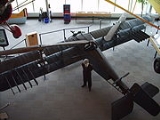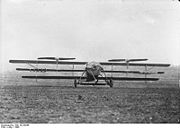
Henry Berliner
Encyclopedia
Henry Adler Berliner was a United States
aircraft
and helicopter
pioneer.
Sixth son of inventor Emile Berliner
, he was born in Washington, D.C.
. After a short time as aerial photographer with the Army Air Service, in 1919 Henry moved back to Washington to help his father with the helicopter research that had been underway for many years (since 1903 New International Encyclopedia
).
Using a Le Rhône engine of 80 hp mounted on a test stand, Henry was able to hover and move forward, but only with assistants holding on to stabilize the contraption. In 1922, he bought a surplus Nieuport 23
fighter's fuselage, added a Bentley 220 hp engine on the front, and connected it by geared shafts to two horizontal rotors mounted on a truss extending sideways from the fuselage. A third horizontal rotor at the rear provided pitch control.
This was demonstrated at College Park, Maryland to the U.S. Navy’s Bureau of Aeronautics
on June 16, 1922, and is often given (though disputed) as the debut of the helicopter.
In 1923, Henry added a triple set of wings to his prototype, as a backup in case of engine failure. This machine could both hover, and reach forward speeds of 40 mph, but did not have the power to gain much altitude; its best performance, on February 23, 1924, reached an elevation of just 15 feet.
A 1925 biplane-like design was lighter and more efficient, but performed little better and was the Berliners' last experiment. In the following year, Henry founded the Berliner Aircraft Company and went on develop various fixed-wing aircraft. The company merged to form Berliner-Joyce Aircraft
in 1929 and was acquired by North American Aviation
a few months later; in 1930 Berliner founded Engineering and Research Corporation
(ERCO).
 The triplane helicopter
The triplane helicopter
was donated to the Smithsonian Institution
. A part of the collection at the National Air and Space Museum
, it presently is on loan to the College Park Aviation Museum.
United States
The United States of America is a federal constitutional republic comprising fifty states and a federal district...
aircraft
Aircraft
An aircraft is a vehicle that is able to fly by gaining support from the air, or, in general, the atmosphere of a planet. An aircraft counters the force of gravity by using either static lift or by using the dynamic lift of an airfoil, or in a few cases the downward thrust from jet engines.Although...
and helicopter
Helicopter
A helicopter is a type of rotorcraft in which lift and thrust are supplied by one or more engine-driven rotors. This allows the helicopter to take off and land vertically, to hover, and to fly forwards, backwards, and laterally...
pioneer.
Sixth son of inventor Emile Berliner
Emile Berliner
Emile Berliner or Emil Berliner was a German-born American inventor. He is best known for developing the disc record gramophone...
, he was born in Washington, D.C.
Washington, D.C.
Washington, D.C., formally the District of Columbia and commonly referred to as Washington, "the District", or simply D.C., is the capital of the United States. On July 16, 1790, the United States Congress approved the creation of a permanent national capital as permitted by the U.S. Constitution....
. After a short time as aerial photographer with the Army Air Service, in 1919 Henry moved back to Washington to help his father with the helicopter research that had been underway for many years (since 1903 New International Encyclopedia
New International Encyclopedia
The New International Encyclopedia was an American encyclopedia first published in 1902 by Dodd, Mead and Company. It descended from the International Cyclopaedia and was updated in 1906, 1914 and 1926.-History:...
).
Using a Le Rhône engine of 80 hp mounted on a test stand, Henry was able to hover and move forward, but only with assistants holding on to stabilize the contraption. In 1922, he bought a surplus Nieuport 23
Nieuport 17
|-Specifications :-See also:-Bibliography:* Bruce, Jack. "Those Classic Nieuports". Air Enthusiast Quarterly. Number Two, 1976. Bromley, UK:Pilot Press. pp. 137–153....
fighter's fuselage, added a Bentley 220 hp engine on the front, and connected it by geared shafts to two horizontal rotors mounted on a truss extending sideways from the fuselage. A third horizontal rotor at the rear provided pitch control.
This was demonstrated at College Park, Maryland to the U.S. Navy’s Bureau of Aeronautics
Bureau of Aeronautics
The Bureau of Aeronautics was the U.S. Navy's material-support organization for Naval Aviation from 1921 to 1959. The bureau had "cognizance" for the design, procurement, and support of Naval aircraft and related systems...
on June 16, 1922, and is often given (though disputed) as the debut of the helicopter.
In 1923, Henry added a triple set of wings to his prototype, as a backup in case of engine failure. This machine could both hover, and reach forward speeds of 40 mph, but did not have the power to gain much altitude; its best performance, on February 23, 1924, reached an elevation of just 15 feet.
A 1925 biplane-like design was lighter and more efficient, but performed little better and was the Berliners' last experiment. In the following year, Henry founded the Berliner Aircraft Company and went on develop various fixed-wing aircraft. The company merged to form Berliner-Joyce Aircraft
Berliner-Joyce Aircraft
Berliner-Joyce Aircraft was an American aircraft manufacturer. It was founded on 4 February 1929 when Henry Berliner and his 1922 company, Berliner Aircraft Company of Alexandria, Virginia, joined with Temple Nach Joyce....
in 1929 and was acquired by North American Aviation
North American Aviation
North American Aviation was a major US aerospace manufacturer, responsible for a number of historic aircraft, including the T-6 Texan trainer, the P-51 Mustang fighter, the B-25 Mitchell bomber, the F-86 Sabre jet fighter, the X-15 rocket plane, and the XB-70, as well as Apollo Command and Service...
a few months later; in 1930 Berliner founded Engineering and Research Corporation
Engineering and Research Corporation
Engineering and Research Corporation was started by Henry Berliner in 1930. Berliner was the son of Emile Berliner, who had patented numerous inventions relating to sound and acoustics, and pioneer of helicopter development with the experimental Berliner Helicopter.The younger Berliner founded...
(ERCO).

Berliner Helicopter
The Berliner Helicopters were a series of experimental helicopters built by Henry Berliner between 1922 and 1925. The helicopters had only limited controllability but were the most significant step forward in helicopter design in the USA until the production of the Vought-Sikorsky VS-300 helicopter...
was donated to the Smithsonian Institution
Smithsonian Institution
The Smithsonian Institution is an educational and research institute and associated museum complex, administered and funded by the government of the United States and by funds from its endowment, contributions, and profits from its retail operations, concessions, licensing activities, and magazines...
. A part of the collection at the National Air and Space Museum
National Air and Space Museum
The National Air and Space Museum of the Smithsonian Institution holds the largest collection of historic aircraft and spacecraft in the world. It was established in 1976. Located in Washington, D.C., United States, it is a center for research into the history and science of aviation and...
, it presently is on loan to the College Park Aviation Museum.

